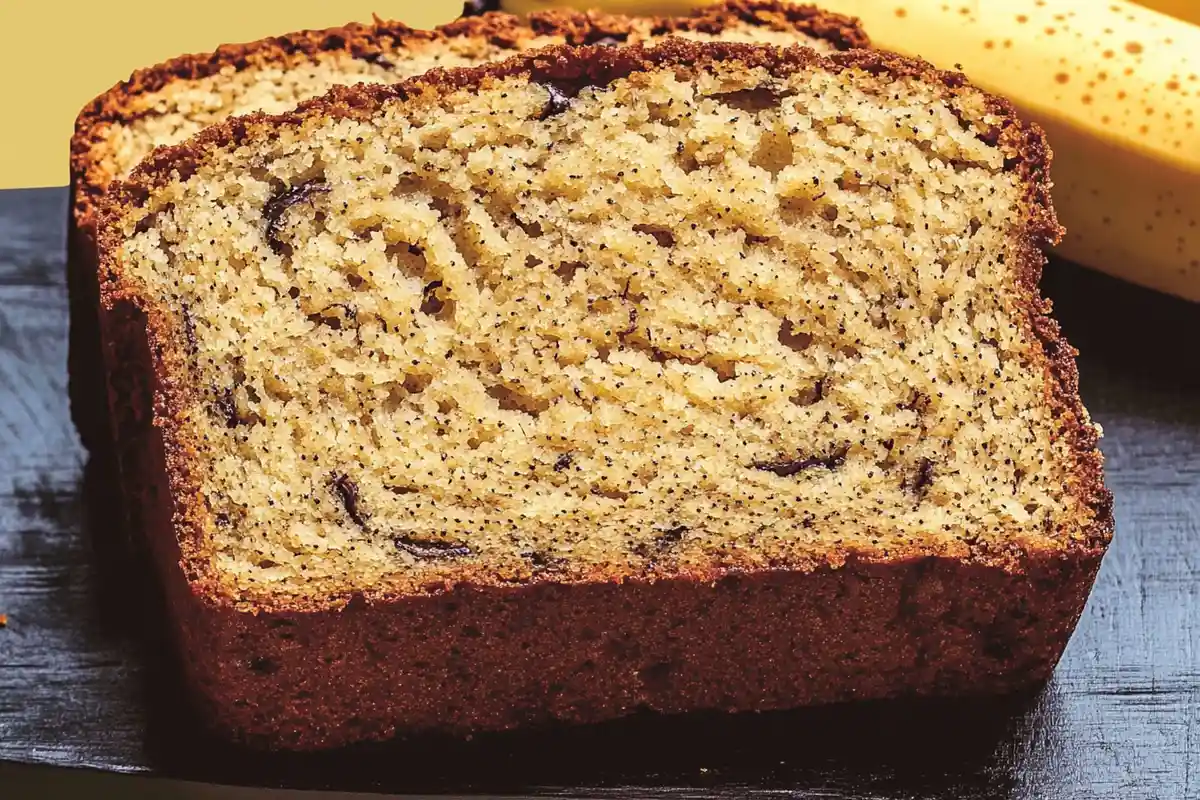Banana bread has long been a beloved baked treat across homes worldwide. Known for its soft texture and naturally sweet flavor, it’s a perfect way to use overripe bananas while indulging in homemade delight. However, traditional recipes often rely heavily on butter, which may not suit everyone. Whether you’re avoiding dairy, aiming for a lower-fat option, or simply running out of butter, a banana bread recipe without butter is the answer.
This article dives deep into the why and how of making this delicious variation, exploring ingredient substitutions, health benefits, and step-by-step preparation methods. Get ready to whip up a loaf that’s just as moist, fluffy, and flavorful—without compromising on taste.
Table of Contents
Understanding Banana Bread Without Butter
Banana bread without butter isn’t just an alternative; it’s a smart twist on a classic recipe. By replacing butter with healthier or more accessible substitutes, you can enjoy a version that aligns with dietary needs, lifestyle choices, or pantry availability.
The Popularity of Banana Bread
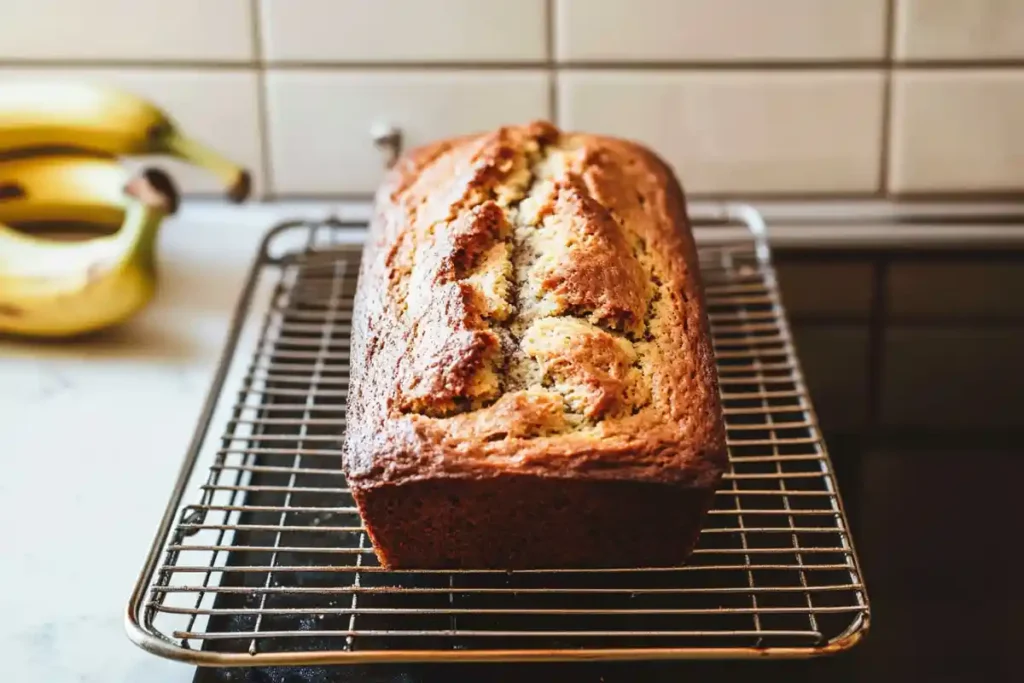
Banana bread isn’t just a baked good; it’s a cultural phenomenon. Its rise in popularity can be attributed to its versatility and simplicity. From cozy family brunches to quick breakfasts on busy mornings, banana bread remains a go-to comfort food. Plus, the natural sweetness from overripe bananas eliminates the need for excessive sugar.
During global events like lockdowns, banana bread recipes surged in online searches as people rediscovered the joy of home baking. Now, with butter-free versions gaining traction, this beloved treat is reaching even more tables.
Reasons to Avoid Butter in Baking
Butter may be a staple in many baking recipes, but there are valid reasons to skip it in your banana bread.
Dietary Restrictions and Preferences
For individuals following dairy-free, vegan, or lactose-intolerant diets, butter isn’tisn’t an option. A banana bread recipe without butter ensures inclusivity without sacrificing taste or texture. Additionally, plant-based diets are on the rise, and butter alternatives like coconut oil or applesauce fit seamlessly into these lifestyles.
Health Considerations
Let’s face it: butter is high in saturated fats. While a little indulgence is acceptable, too much can have health consequences. Substitutes like vegetable oil or Greek yogurt reduce saturated fat content while maintaining that moist, rich consistency. Moreover, banana bread without butter often aligns with heart-healthy dietary choices.
Benefits of Butter-Free Banana Bread
If you’re wondering whether butter-free banana bread can match the classic recipe’s charm, the answer is a resounding yes!
Moisture and Texture
One of the standout features of a butter-free banana bread is its incredible moisture. Substitutes like vegetable oil, applesauce, or even mashed avocado lock in hydration, preventing your loaf from becoming dry or crumbly. Some even argue that oil-based banana bread stays fresher for longer!
Flavor Profiles
Without butter overpowering the taste, the natural sweetness and richness of ripe bananas truly shine. Additionally, depending on the substitute—like coconut oil or yogurt—you might discover subtle new flavors that add depth to your banana bread.
If you’re looking for a healthier banana bread recipe, this resource offers a fantastic variation using yogurt instead of butter.
In short, butter-free banana bread is not just an alternative—it’s a recipe worth celebrating. With the right substitutes, you’ll be able to enjoy all the goodness of traditional banana bread while meeting your dietary and health goals.
Key Ingredients for Banana Bread Without Butter
Crafting the perfect banana bread recipe without butter hinges on selecting the right ingredients. While butter contributes moisture and richness in traditional recipes, its substitutes can offer equally delicious—and sometimes even better—results. This section will break down each essential component, highlighting smart swaps, flavor enhancers, and the best choices for an irresistibly moist loaf.
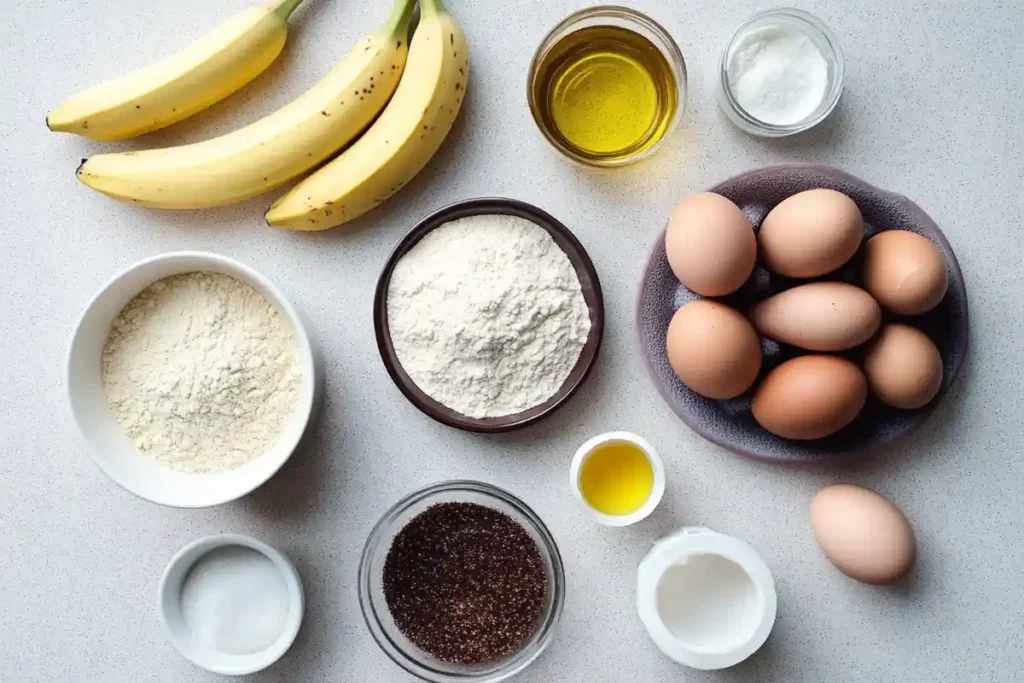
Choosing the Right Bananas
Bananas are the heart and soul of any banana bread recipe. Without butter, their role becomes even more crucial in providing natural moisture and sweetness.
Ripeness and Sweetness
The riper the banana, the sweeter and more flavorful your banana bread will be. Look for bananas with deep brown spots on the peel—almost too ripe to eat. These bananas are naturally sweeter and softer, blending effortlessly into the batter. If your bananas aren’t ripe enough, don’t worry! A quick trick is to bake them in the oven at 300°F (150°C) for about 15 minutes until they turn dark and syrupy.
Additionally, ripe bananas enhance the bread’s moisture content, compensating for the absence of butter.
Oil as a Butter Substitute
Oil is arguably the most common and reliable substitute for butter in banana bread. It keeps the loaf moist and tender without altering the flavor profile too much.
Types of Oils Suitable for Baking
Not all oils are created equal when it comes to baking. Here are the best options:
- Vegetable Oil: Vegetable oil is a neutral-tasting choice that doesn’t overshadow the banana flavor. It’s budget-friendly and widely available, and it ensures a soft crumb.
- Coconut Oil: Coconut oil adds a subtle tropical aroma and richness to your banana bread. For best results, use refined coconut oil if you prefer to avoid a pronounced coconut flavor.
- Olive Oil: While unconventional, olive oil can be a fantastic substitute. It brings a light, fruity note to the bread, elevating its overall taste. Opt for light olive oil instead of extra virgin for a milder profile.
If you’re curious about different oil options and their impact on texture, check out this resource on healthier banana bread alternatives.
Alternative Moisture Enhancers
When omitting butter, achieving the perfect texture often depends on secondary moisture boosters.
- Applesauce: Unsweetened applesauce is a classic butter alternative. It keeps the loaf moist while adding a slight fruity note. Plus, it’s low in fat and calories—a win-win!
- Yogurt: Plain yogurt, whether regular or Greek, brings tanginess and creaminess to banana bread. It also boosts the protein content, making your loaf slightly more nutritious.
- Sour Cream: Sour cream is another excellent option. Its rich, creamy texture ensures a dense yet tender crumb. If you’re feeling adventurous, try mixing yogurt and sour cream for an ultra-moist result.
Sweeteners and Their Impact
Sweeteners do more than add sugar—they influence the moisture, texture, and even shelf life of your banana bread.
- Brown Sugar vs. White Sugar: Brown sugar contains molasses, which adds depth and a subtle caramel flavor to the bread. It also contributes to a denser, moister texture. White sugar, on the other hand, keeps the loaf lighter and sweeter.
- Honey or Maple Syrup: Liquid sweeteners like honey or maple syrup can replace sugar while adding their unique flavor profiles. Honey imparts a floral sweetness, while maple syrup introduces a warm, earthy taste. Just be mindful of adjusting the liquid ratios in your recipe when using these alternatives.
Optional Add-ins for Flavor and Texture
Add-ins can take your banana bread from simple to extraordinary. They introduce texture, flavor pops, and visual appeal.
- Nuts and Seeds: Walnuts, pecans, or even sunflower seeds add crunch and richness to each bite. Toast them beforehand to intensify their flavor.
- Chocolate Chips: Who can resist a bit of chocolate in banana bread? Semi-sweet or dark chocolate chips create pockets of gooey goodness, elevating your loaf’sloaf’s indulgence factor.
- Dried Fruits: Raisins, cranberries, or chopped dates bring chewy sweetness to the loaf. Just ensure they’re they’re plump and not overly dry before mixing them in.
Incorporating these thoughtfully chosen ingredients will ensure your banana bread without butter isn’t just a compromise—it’s a superior alternative. From ripe bananas to clever substitutes like oil, applesauce, and yogurt, each ingredient plays a key role in creating a loaf that’s moist, flavorful, and downright irresistible.
How to Prepare Banana Bread Without Butter
Making a banana bread recipe without butter isn’t just about swapping ingredients—it’s about perfecting the technique. From gathering the right tools to baking your loaf to golden perfection, every step matters. Whether you’re you’re a seasoned baker or a first-timer, this guide will ensure your banana bread comes out moist, flavorful, and utterly delicious every time.
Equipment Needed
Before diving into the mixing and baking, let’s ensure you have the right tools on hand. Proper equipment not only makes the process smoother but also guarantees consistent results.
- Mixing Bowls: You’ll need at least two mixing bowls—one for the dry ingredients and another for the wet mixture. Opt for medium to large bowls to allow enough room for thorough mixing without spills.
- Measuring Cups and Spoons: Precision is key in baking. Use measuring cups for dry ingredients and liquid measuring cups for wet ingredients. Don’t eyeball—accuracy ensures your loaf rises perfectly.
- Loaf Pan: A standard 9×5-inch loaf pan works best for banana bread. If you’re using a smaller or larger pan, be prepared to adjust the baking time accordingly. Grease it well or line it with parchment paper for easy removal.
Preparation Steps
- Preheating the Oven: Start by preheating your oven to 350°F (175°C). A properly preheated oven ensures even baking and prevents undercooked centers.
- Preparing the Loaf Pan: Lightly grease your loaf pan with oil or non-stick spray, or line it with parchment paper. This prevents the banana bread from sticking and makes cleanup a breeze.
Mixing Dry Ingredients
In one mixing bowl, combine:
- All-purpose flour
- Baking soda
- Baking powder
- A pinch of salt
Whisk them together to distribute the leavening agents and prevent clumps evenly.
Combining Wet Ingredients
In the second mixing bowl, mix:
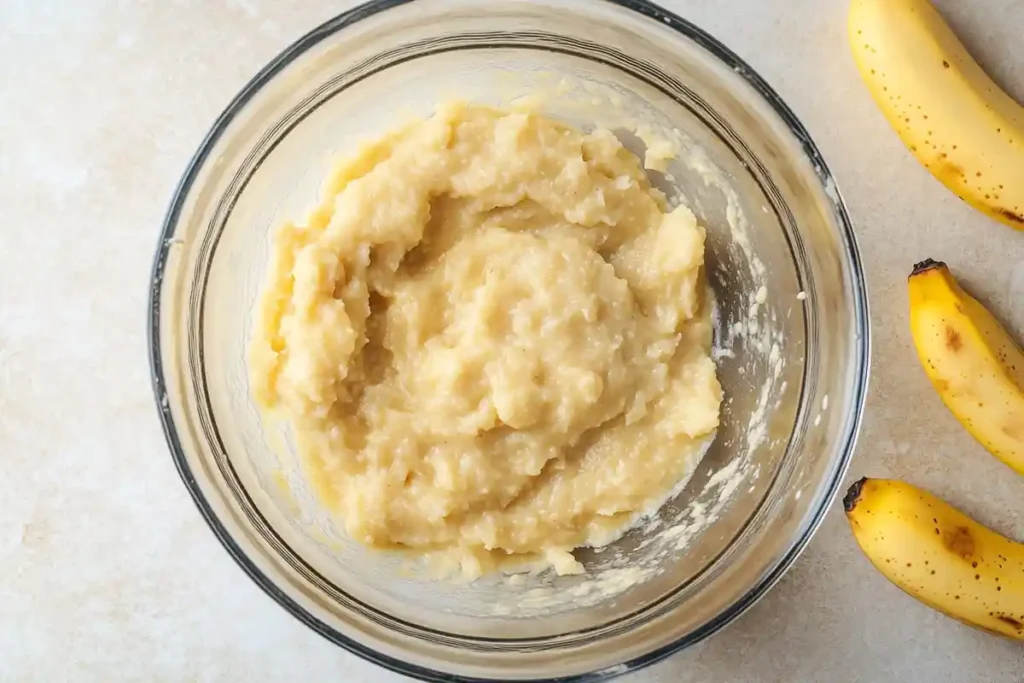
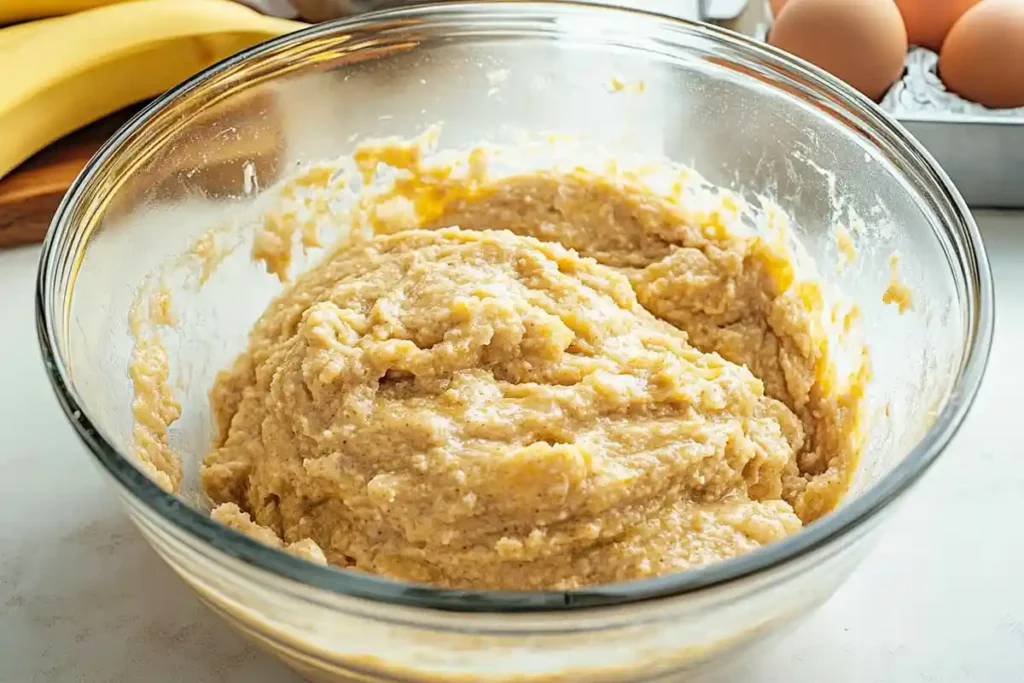
- Mashed ripe bananas
- Oil (vegetable, coconut, or olive)
- Eggs
- Vanilla extract
- Sweetener (sugar, honey, or maple syrup)
Stir until everything is well incorporated, but avoid overmixing, as this can make your bread dense.
Incorporating Bananas
Add your mashed bananas to the wet mixture, ensuring they’re thoroughly blended in. The banana puree acts as a natural sweetener and moisture enhancer, creating a tender crumb.
Folding in Add-ins
If you’re adding nuts, chocolate chips, or dried fruits, now’s the time! Gently fold them into the batter using a spatula. Overmixing at this stage can crush these add-ins and affect the loaf’s loaf’s texture.
Pouring Batter into the Pan
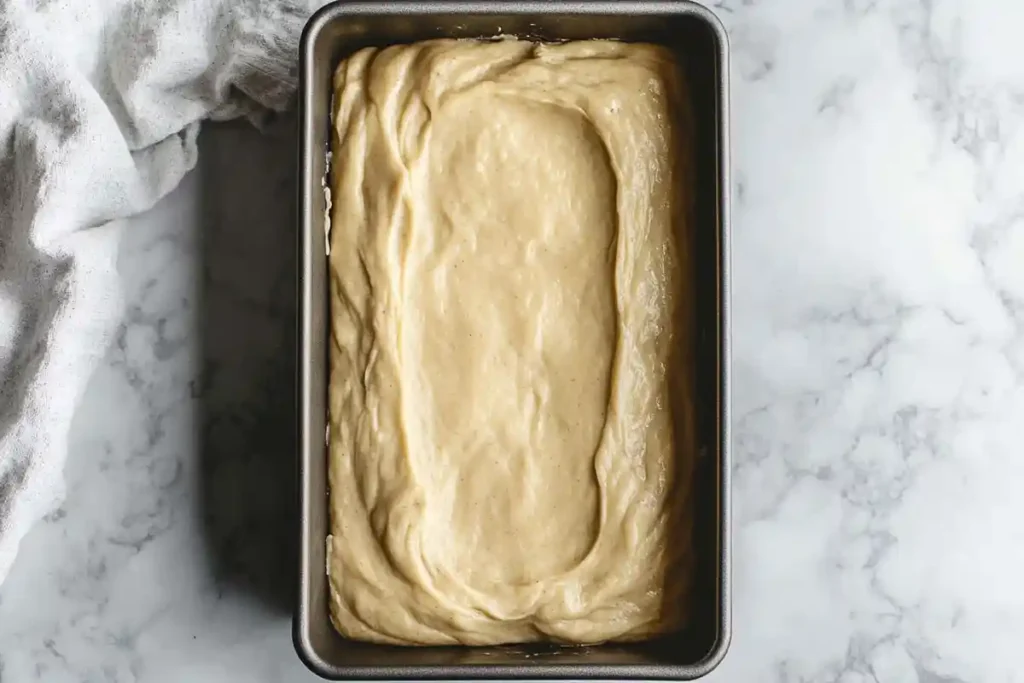
Pour the prepared batter evenly into the greased loaf pan. Smooth the top with a spatula to ensure it bakes uniformly. Give the pan a gentle tap on the counter to release any trapped air bubbles.
Baking Instructions
Optimal Baking Time and Temperature
Place your loaf pan in the center rack of your preheated oven. Bake for approximately 50–60 minutes at 350°F (175°C). Keep an eye on the top—if it browns too quickly, loosely cover it with aluminum foil.
Testing for Doneness
To check if your banana bread is ready, insert a toothpick or skewer into the center. If it comes out clean or with just a few moist crumbs (not wet batter), it’s done! If not, bake for an additional 5–10 minutes and test again.
Pro Tip: Avoid overbaking, as this can dry out the loaf.
If you want a foolproof guide to baking healthier banana bread variations, check out this step-by-step recipe.
Cooling and Serving
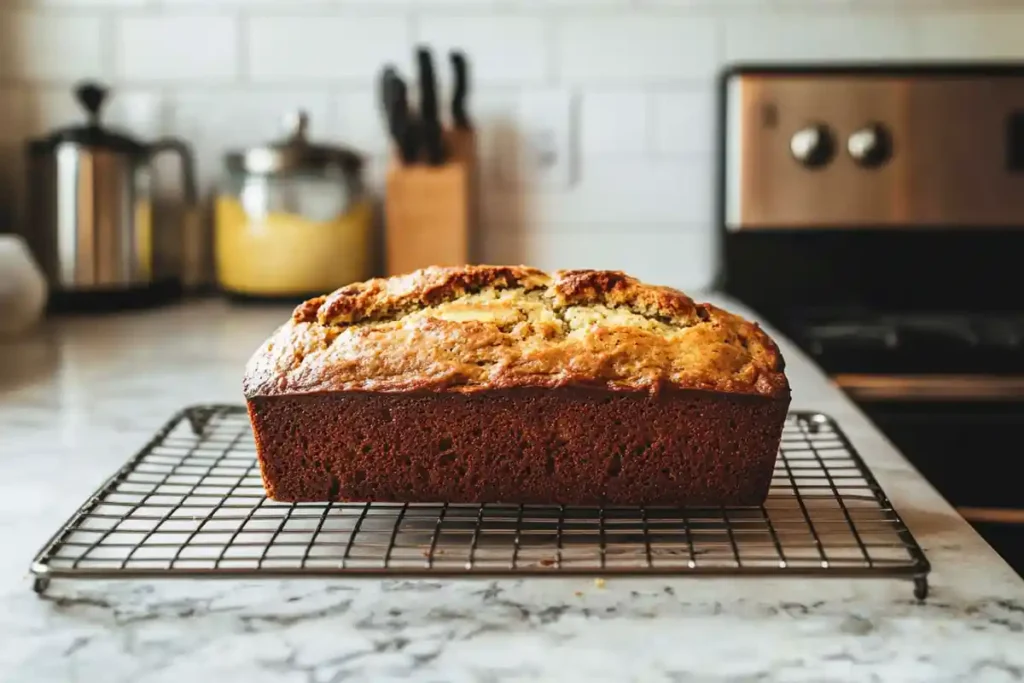
- Cooling on a Wire Rack: Once baked, remove the loaf from the oven and let it cool in the pan for about 10–15 minutes. Then, transfer it to a wire cooling rack to cool completely. It prevents the bottom from becoming soggy.
- Slicing Techniques: Use a sharp, serrated knife to slice your banana bread. For clean cuts, ensure the loaf is thoroughly cooled. If you can’t wait, at least let it cool partially to avoid crumbly slices.
- Serving Suggestions: Banana bread without butter pairs beautifully with:
- A warm cup of coffee or tea
- A dollop of Greek yogurt
- A drizzle of honey or maple syrup
- You can also lightly toast the slices for an extra layer of texture and flavor.
With these step-by-step instructions, baking a banana bread recipe without butter becomes a breeze. Every detail, from preheating the oven to the final slice, plays a role in ensuring your loaf turns out moist, flavorful, and bakery-quality.
FAQs About Banana Bread Without Butter
When it comes to baking banana bread without butter, questions are bound to arise. Whether you’re curious about substitutions, health benefits, or the best oils to use, this section aims to clear up the confusion. Let’s address some of the most common questions about butter-free banana bread.
Can I Substitute Butter for Banana?
Butter and bananas seem like unlikely substitutes, but they can share overlapping roles in baking.
What Is the Best Oil to Use When Making Banana Bread?
Oils are the most common butter replacement, but choosing the right one can make all the difference.
Is Butter or Oil Better for Banana Bread?
Comparing Different Oils
Vegetable Oil: Neutral flavor, budget-friendly, and reliable.
Coconut Oil: Adds a subtle tropical note and works well in dairy-free recipes.
Olive Oil: Offers a light fruity flavor; opt for light olive oil for a milder taste.

